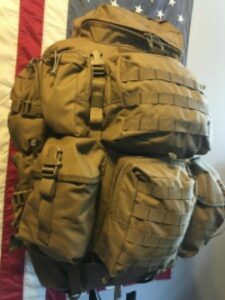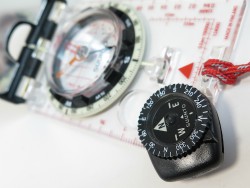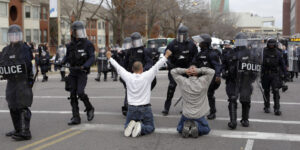
If you tried to get through an airport security checkpoint with your bugout bag as a carry on, what would set off the alarms?
by Doc Montana, contributing writer
The obvious offenders would be your gun, your knives, your water, your pepper spray, and many of your tools. But happily, the list of what you can take past security is actually quite long. The TSA lists the things on its no-fly list in this brochure.
While I am quick to buy prohibited items after I land including a knife and lighter, some notable TSA approved carry-on-able items include one book of safety matches, sub 7-inch tools including screwdrivers, wrenches and pliers, and scissors with plastic tips and blades of less than four inches’ length.
Of course, the absolute decision of whether or not any given item is allowed through security rests with the on-site security agents, so nothing is in stone and much may depend on your presentation and attitude – and perhaps the mood of any given agent. So don’t count on everything you see on the TSA’s website or read in a prepper’s blog. Add to this the variety of different country’s airports and the rolling global security alerts, and your mileage may vary wildly.
Getting Through Airport Security

I know I’m not alone when I curse bin Laden’s name every time I have to endure the airport security lines and screenings, but I’ve also traveled enough to feel comfortable with the limits place upon me. But no, I’m not happy about it. And I also know I’m not alone when it comes to wondering just what would happen if another 9/11 forced my plane to land somewhere completely unexpected. Or that I’m just one or two engine failures away from a hard landing in snowy mountains.
Two directions of BOB thinking can be combined into one effective collection of TSA approved items increasing your chance of survival or making it back home. One line of thought is surviving long enough to be rescued; the other is fighting your way back home.
Some Tips on Your Bug Out Bag Items
Consider what you should have on your person compared to in your carry-on bag. In an emergency situation you better not be clogging my exit with your backpack. So after I am though security, I rearrange my gear and pocket the most important items. I also have a smaller “murse” or man-purse that can be accessed quickly, carried easily, and won’t impede my way to the closest exit, which may be behind me.
Many traditional BOB ingredients are just fine, but the size or quantity may need to be reduced. Plus, you should adjust your outerwear for the season or potential flyover areas.
The TSA-Compliant Bug Out Bag

My TSA compliant BOB / Get Home bag includes (at a minimum) the following, with my brand/model suggestions actively linked. However, it is important to note that this list has air travel and airport security in mind. The actual individual items would most certainly change if the TSA were out of the equation. I have had international travel experience with all the items, never encountered a problem. A few odd looks, but no problems.
The list:
- Two small to medium water bottles (you can fill them after passing through the security checkpoint). The smaller sizes are easier to fill and stow.
- Powerbar-type foods, nuts, gum
- Paracord
- Duct tape
- Flashlight (with AA batteries)
- Headlamp (with AA batteries)
- Water purification tablets
- Compass with mirror
- Watch
- Cell phone with extra battery pack (charged)
- Gore Wind Stopper stocking cap
- AM/FM/weather radio like the Sony SRF-M37V with earbuds (with AA batteries)
- TSA compliant Leatherman multitool
- TSA compliant scissors
- GPS with maps chip (with AA batteries)
- Titanium cup (can cook/boil water in it over fire)
- Book of matches in watertight bag
- Ferrocerium rod
- A dozen TinderQuik® fire tabs
- Zip ties
- Soap, small bar
- Aspirin or other pain reliever
- Foam earplugs
- Fisher Space Pen
- Small first aid kit
- Sanatary wipes/alcohol sanitizer
- Micro-sized Fishing kit
- Lightweight Gore-Tex parka
- Adventure Medical Kits SOL Emergency Bivvy
- 2 Carabiners
- Three yards of half-inch tubular webbing
- Tactical Pen (but not too tactical)
- Schrade titanium pry tool (hardly a “pry bar” at only 3.25 inches)
- Two 1-gallon Ziploc freezer bags
- Small Rite-in-the-Rain notebook
- Leather gloves
- Small pliers
- Bandanna
- Buff® facemask
- Two 3M 9211 folding particulate masks
- Drop pouch for fast storage (I recommend 5.11)

You should also wear comfortable and durable walking shoes, and natural fiber shirt, pants, and socks (most non-natural fibers melt around fire).
The above items, along with my usual travel garb and tech are divided into three categories: those things on me (think in pockets or worn around the neck, wrist or waist), those things in my murse (which is often a Maxpedition or SpecOps organizer), and those in my traditional carryon bag/backpack.
Related: 8 Tips for Flying with a Firearm
Those things on me include the TSA compliant Leatherman, the tactical pen, cell phone, flashlight, watch, Ferrocerium rod, and the pry tool.
Those things in my murse include some but not all the Powerbars/Omnibars, paracord, duct tape, headlamp, water purification tablets, scissors, compass, GPS, Tinder Tabs, first aid kit, some zip ties, micro fishing kit, pliers, notebook, one freezer bag, bandana, Fisher Space Pen, Buff mask, one particulate mask, and one carabiner on the outside.
Carry-On Luggage Logic


All the rest goes in my normal carry-on bag. Speaking of which, here are my rules of thumb for a carry-on bag.
First, you must be able to wear it without holding on to it so you can run and climb using both hands. I prefer technical climbing backpacks or higher-end computer backpacks when flying. Tactical backpacks are fine when on your home turf.
Your carry-on should not attract undue attention from either color or tacticalness. Some airport security (mostly outside the US) take special interest in military-looking luggage, so take it easy on the MOLLE, morale patches, flags, OD green, and camo.
Put the items most likely to attract attention by security screeners in obvious places or even outside the bag. This includes the tactical pen (during the security check I often have it in the writing position with the cap off), the pry tool, the scissors, pliers, the Leatherman, and the water bottles. The titanium cup might also need a second look so that is a good one to clip to the outside of your pack for its journey through the x-ray machine. Then – please – promptly stow it back in your pack so you don’t look like one of those goofy Hollywood actor-types appear like a seasoned hiker with a cup clanking around as you walk.
Make it Easy for TSA
What you do want is to have the TSA easily see questionable items, and find them quickly when searched for. You cannot win an argument with the TSA agents so be prepared to lose your item, or possibly mail it back home – a service offered in some airports. In other words, don’t pack any heirloom-quality survival tools or items you don’t want to lose.
I’ve had good luck attaching the Leatherman and the pry tool to my car keys, sending the water bottles through on their own, and putting the tool-like stuff in with my computer cables or camera equipment. You don’t want to appear to be hiding anything, or potentially be up to something nefarious. You’re just a seasoned road warrior, which is exactly right. Right?
The final tip is to use your brain and trust your instincts. I cannot count the number of times my flights have deviated from their intended courses whether in schedule, landing site, travel comfort, or in-flight emergency.
I am quite practiced in the art of sleeping in airports and train stations where a quick analysis of traffic flow, food services, bathroom proximity, lighting, power outlets, and walls and corners to my back will ensure I have the best option when it’s obvious this is the end of the line for today. Oh, and have plenty of cash on hand in various currencies, but especially good old American greenbacks.
Problem Flights
I was on this Delta flight: Chaos at the Cape Town Airport.
A couple juicy tidbits left out of the news story include the pilot got typhoid fever while visiting an orphanage. There were no on-site agents able to make decisions so all communication had to go through HQ in Atlanta (middle of the night there, BTW). The plane’s flight number was changed so all tickets had to be re-booked so absolutely no connecting flight reservations were maintained.
No hotels were booked that night (like you could book 300 hotel rooms at 1 am anyway). Surface transportation was unavailable for many hours. And my all-time favorite, we had already boarded the plane before the announcement was made that we were missing a pilot…which meant we already cleared customs…which meant we were technically not in any country…which meant we could not deplane since customs is a one-way street…which meant we sat for an hour before someone figured out that we could deplane onto a bus, then drive around the tarmac to the arrival gates where customs could process us again into South Africa. And only then could we truly appreciate being stuck without a plan at the southern tip of the world. While hardly a survival situation, it did highlight our personal vulnerability, and dependency on bureaucratic absurdities nine time zones away.
Once in the air, we had back-to-back eight hour flights with only a refueling stop in Dakar. No deplaning in Senegal, however. Just open the plane doors to let in the malaria infected mosquitoes in, and where we could stand at the door threshold looking down 20 feet to the pavement with nothing but a two-inch strap strung across the doorway. Yes folks, the rules seem to change with the country. We landed at JFK at 2 AM. Nobody home. Not surprising, really, after all the half-truths and non-truths we were fed during the flight.
I remember standing next to the pilot outside the terminal as he was yelling into his cell phone to get some help out here. Two hours later, the first shift of Delta agents arrived to discover 300 rather angry passengers. In true airport form, more workers were immediately brought in – but they were armed security guards ready to enforce the peace.
In the end, it just confirmed that even though you are packed into a metal tube with 300 other people, you are also totally on your own.
9 comments
Other flying preps:
– If you’ll be flying over water, buy a seat next to an exit door and while you’re flying, think about how to use it. If you’re not near an exit door, count the rows between yourself and the nearest one so you can find it in a dark, chaotic situation.
– Include two heavy-duty “contractor” garbage bags in your kit and if you’re in trouble over water, stuff your kit into one and tie a knot. Be ready to blow the other up to use as a float.
– Use a stout nylon cord to tie your kit around your waist or if your kit has a shoulder strap, put it on.
– Remember that your seat is also a float. Be ready to grab it.
– Be ready to kick off your shoes.
I learned recently that those lovely airline attendants, look at what you are wearing and how you conduct yourself. They try to identify anyone who they feel could be called upon to help them in an emergency.
Some questions:
-What are the dimensions of your “TSA-Compliant Bug Out Bag”? In the photo it looks pretty big (but maybe it’s not…can’t really tell.) Does it fit in the airline’s “size-wise” device at the check in counter or gate? Is it no larger than 9″ x 10″ by 17″?
-One airline, for example, United Airlines, allows “one carry-on bag 9″ x 14″ x 22″ MAX and a small personal item, such as a laptop or a lady’s purse, 9″ x 10″ x 17″ MAX”. So if either bag is bigger than that, might the airline you’re flying on require you to check either your carry-on suitcase or your “TSA-Compliant Bug Out Bag”, or even both?
-How much does your “TSA-Compliant Bug Out Bag” weigh, outfitted as you describe?
Sidelier, that was a stock photo I pulled from the SHTFblog archives for a picture when posting the article. I’m sure Doc Montana will chime in with a better handle on his bag dimensions. -Drew
Hi Sidelier
Thanks for the read.
There are many options for the bag, but in in reality, the contents weigh little more than a few pounds outside the water bottle. The largest items are the parka, the gloves, and the bivy sack.
To be specific, I often use a 5.11 6×10 vertical zipper pouch to pack in the supplies, and the backpack is my carryon. The pouch has plenty of room while being relatively small. I can scale it to meet any immediate needs.
The point of a TSA bug out kit is something small, fast, light, and innocuous. And, of course, effective.
More than one time I’ve held the BOB between my feet in the middle of turbulence, those moments have opened my mind over what could happen in the case of a sea landing. One of them is that it is maybe a good idea to have airbags inside of it, like those used in amazon’s boxes for delivery, so my BOB will float and would’t get drowned in the sea.
Great article by the way.
thats why i refuse to fly any longer at all
The food is a mistake (extra weight) and a comfort item, at best. If you want to pack something, pack electrolytes. The average American could do three weeks or more of ZERO food with little impairment.
TSA no longer allows tactical pens in carry-on. I just had mine taken from me on a flight to Nashville. My suggestion is to find a very stout old fashion Bic pen. Bic used to have a commercial where they shot the pen out of some type of firearm into a wood board. The pen could still write. My other suggestion is to take an improvised weapons course. It was there I learned that airlines cannot take away a cane or walking stick. I now use one whenever I fly.